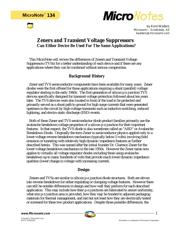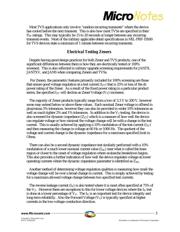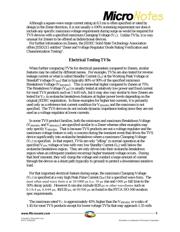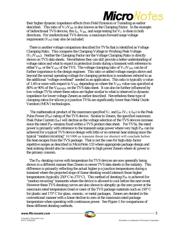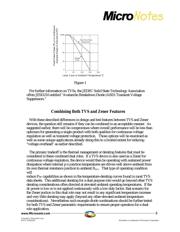Datasheet 搜索 > 齐纳二极管 > Microsemi(美高森美) > 1N5361BE3/TR8 数据手册 > 1N5361BE3/TR8 开发手册 4/10 页

¥ 14.291
1N5361BE3/TR8 开发手册 - Microsemi(美高森美)
制造商:
Microsemi(美高森美)
分类:
齐纳二极管
封装:
T-18
Pictures:
3D模型
符号图
焊盘图
引脚图
产品图
页面导航:
应用领域在P1
导航目录
1N5361BE3/TR8数据手册
Page:
of 10 Go
若手册格式错乱,请下载阅览PDF原文件

www.Microsemi.com
_______________________________________________________________________________
4
Copyright Microsemi Corp.
Rev 0; 8/26/2010 MicroNote is a trademark of Microsemi Corporation
Although a square-wave surge current rating at 8.3 ms is often specified or rated by
design in the Zener direction, it is not usually a 100% screening requirement nor does it
include any specific maximum voltage requirement during surge as would be required for
TVS devices with a specified maximum Clamping Voltage (V
C
). Unlike TVSs, it is very
unusual for Zeners to be offered as bidirectional devices.
For further information on Zeners, the JEDEC Solid State Technology Association
offers JESD211 entitled “Zener and Voltage Regulator Diode Rating Verification and
Characterization Testing”.
Electrical Testing TVSs
When further comparing TVSs for electrical parameters compared to Zeners, similar
features may be called by different names. For example, TVSs are also tested for reverse
leakage current or what is called Standby Current (I
D
) at the Working Peak Voltage or
Standoff Voltage (V
WM
) that is typically 80% or 90% of the specified minimum
Breakdown Voltage (V
BR(MIN)
). This is somewhat higher compared to Zeners at 75%.
The Breakdown Voltage (V
BR
) is usually tested at relatively low power and fixed current
for most TVS products such as 1 to10 mA, but it may also vary similar to how Zeners are
tested for V
Z
in avalanche breakdown features at higher power levels depending on the
original JEDEC registration. In those examples for higher test currents, it is primarily
used only as a reference test current condition for V
BR(MIN)
and the maximum is not
specified. The TVS devices do not include dynamic impedance testing since they are not
used as a voltage regulator at lower currents.
In some TVS product families, both the minimum and maximum Breakdown Voltage
(V
BR(MIN)
and V
BR(MAX)
) are specified similar to a Zener whereas other examples may
only specify V
BR(MIN)
. That is because TVS products are not a voltage regulator and the
maximum voltage feature is only a concern during the transient event that drives the TVS
device significantly into avalanche breakdown where a maximum Clamping Voltage
(V
C
) is specified. In that respect, TVSs are only “idling” in normal operation at the
specified V
WM
voltage or less with very low Standby Current (I
D
) well below the
avalanche breakdown region. They are only driven into their avalanche breakdown
region when an infrequent (random recurring) higher transient voltage occurs. During
that brief moment, they will clamp the voltage and conduct a large amount of current
through the device as a shunt path (typically to ground) to protect a downstream sensitive
load.
For that important electrical feature during surge, the maximum Clamping Voltage
(V
C
) is specified at a very high Peak Pulse Current (I
PP
) for a specified wave form. The
most often used wave form is at 10/1000 μs (i.e. 10 μs rise and 1000 μs fall time to the
50% decay point). However it can also include 8/20 μs or other waveforms such as
0.1/6.4 μs, 6.4/69 μs, 40/120 μs, or 50/500 μs as found in the RTCA DO-160 aviation
spec requirements.
The maximum rated V
C
is approximately 45% higher than the V
BR(MIN)
or a ratio of
1.45 for most TVS products except for lower voltage TVSs that may approach 1.55 with
器件 Datasheet 文档搜索
AiEMA 数据库涵盖高达 72,405,303 个元件的数据手册,每天更新 5,000 多个 PDF 文件

